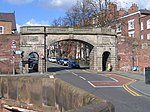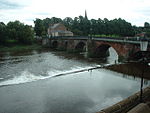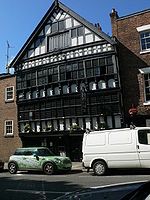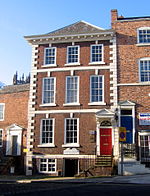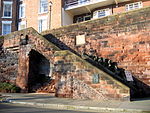Old Dee Bridge
Arch bridges in the United KingdomBridges across the River Dee, WalesBridges completed in the 14th centuryBridges in CheshireBuildings and structures completed in 1387 ... and 7 more
Buildings and structures in ChesterFormer toll bridges in EnglandGrade I listed bridgesGrade I listed buildings in ChesterScheduled monuments in CheshireThomas Harrison buildingsUse British English from December 2016

The Old Dee Bridge in Chester, Cheshire, England, is the oldest bridge in the city. It crosses the River Dee carrying the road that leads from the bottom of Lower Bridge Street and the Bridgegate to Handbridge. A bridge on this site was first built in the Roman era, and the present bridge is largely the result of a major rebuilding in 1387. It is recorded in the National Heritage List for England as a designated Grade I listed building, and is a scheduled monument.
Excerpt from the Wikipedia article Old Dee Bridge (License: CC BY-SA 3.0, Authors, Images).Old Dee Bridge
Handbridge, Chester Handbridge
Geographical coordinates (GPS) Address External links Nearby Places Show on map
Geographical coordinates (GPS)
| Latitude | Longitude |
|---|---|
| N 53.185506 ° | E -2.888718 ° |
Address
Old Dee Bridge
Handbridge
CH1 1SA Chester, Handbridge
England, United Kingdom
Open on Google Maps
